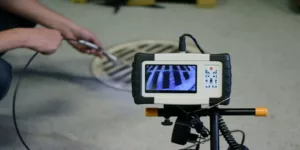Sewer systems take a lot of abuse. Just like any other infrastructure, sewer pipes eventually degrade or become damaged due to tree root invasion. Unfortunately, many homes are connected to aging pipes that were installed decades ago, and many homeowners can benefit from having their pipes replaced or repaired.
Before you can address the problem, a sewer pipe inspection must be performed. Here’s what you need to know about this process:
1. Inspections Should be Scheduled Every Year
Sewer inspections should be performed on an annual basis. Many homeowners make the mistake of only getting an inspection when there’s already a problem. But yearly inspections will allow you to tackle small problems before they become major repairs.
If your home is newly built, you may not have to get an inspection for the first few years, but don’t put off this annual task for too long. A pipe may be new, but it’s not invulnerable.
One of the biggest issues with sewer pipes is tree root invasion. Roots from the trees make their way into tiny openings in the pipes and expand into the sewer line. These roots latch onto debris in the pipes, like grease, and continue expanding. Annual inspections can help catch this problem early on before it causes irreparable damage and serious clogs.
Yearly inspections are also important for older homes. Many homes built in the 1950s have Orangeburg pipes, which are made from tar paper. This material can disintegrate and collapse over time.
2. Inspections are Simple and Effective
A pipe inspection can be performed by a local sewer repair company. The process is much simpler than you might think and doesn’t involve digging up your lawn.
CME Pipe Lining explains the process:
“The camera collects detailed footage of the pipe interior, which is fed in real-time through the attached cable to the viewscreen. Our expert technician works the camera through the pipe, inspecting every inch for signs of damage and decay. The camera is sensitive enough to expose subtle signs of wear, such as micro-fissures and early signs of corrosion around joints.”
The data collected by the camera will allow the repair company to come up with a complete restoration plan that tackles all issues – big and small.
Sewer inspections are simple and can cost up to $300, but they can help save you thousands of dollars in the long-run.
3. Potential Home Buyers Should Always Get a Sewer Inspection
If you’re planning on buying a home, you may want to get a sewer inspection – especially if it’s an older home. A regular home inspection won’t give you an in-depth check of your sewer pipes.
An inspection will tell you whether the sewer line is clean or clogged. It will also tell you the sewer’s condition and the material of the piping. Certain materials are more prone to damage and deterioration than others. Clay, cast iron and Orangeburg were all common pipe materials used in older homes, and they are especially vulnerable to tree root invasion and damage.
4. Inspections Should be Performed by a Trained Professional
It’s important to ensure that your sewer inspection is performed by a trained professional who has experience with this service. Not all plumbers offer sewer inspections because they don’t have the equipment, knowledge or experience to properly inspect sewer pipes.
Look for sewer repair companies that specialize in camera inspections. Typically, these companies offer trenchless repair services, which is a no-dig method of repairing pipes. These companies tend to have the most experience with camera inspections, which also do not require digging to perform.
5. Inspections Can Help You Find Simple Solutions to Small Problems
Sometimes, an inspection will reveal waste build-up in pipes, which can cause clogging. This is usually due to the accumulation of mineral layers, organic material and grease.
If left untouched, these problems could progress into bigger issues that damage your pipes and potentially damage your home. For problems like this, there’s typically a simple and relatively inexpensive solution. Hydro-jetting for example, can clear out debris and clogs without damaging the pipes or hurting the environment. Hydro-jetting sends a highly pressurized stream of water through your pipes (similar to pressure washing your house), which leaves your pipes squeaky clean.








